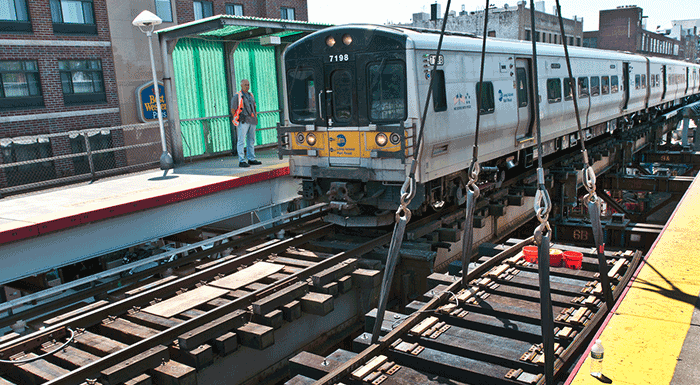Photo Courtesy of Patrick Cashin/MTA LIRR
“Far too many [stations] are underutilized, inaccessible, deteriorating, and locked behind an exorbitant pay wall,” Comptroller Stringer said.
By Michael V. Cusenza
Dozens of Long Island Rail Road stations in Queens and Brooklyn are rife with deteriorating conditions and inaccessibility challenges that inhibit seniors, young children, and people with disabilities, according to City Comptroller Scott Stringer, who recently penned a letter to the president of the railroad detailing these issues and calling on the agency to make improving service, maintenance, and access at Queens and Brooklyn LIRR stations “a pressing priority.”
Currently, according to Stringer, five Queens and Brooklyn stations meet all Americans with Disabilities Act accessibility requirements; and 14 are accessible by wheelchair.
“Despite these troubling accessibility gaps, plans to install an elevator at the Hunterspoint Avenue Station [in Long Island City] were indefinitely postponed, the $3 million ‘station renewal’ at St. Albans Station will not include ADA upgrades, [and] the installation of elevators at the Murray Hill Station is years behind schedule and $6 million over the original budget,” Stringer wrote in his Aug. 7 missive to LIRR President Phillip Eng.
“These conditions are entirely unacceptable, particularly considering the hefty fee that New York City pays to the MTA for station maintenance,” the comptroller added, noting that in Fiscal Year 2019, the City was required to allocate $97.4 million “for the maintenance, use, and operations of local commuter rail stations.”
Stringer said his office has received frequent complaints from area residents and passengers about deteriorating conditions at these stations including old and faded signage, malfunctioning ticket machines, excessive litter, unsanitary conditions, and broken platform surfaces, as well as a lack of elevators or ramps.
“Maintaining and providing equitable access to our public transit system is critical to building a city that works for every New Yorker. The LIRR stations in Queens and Brooklyn should be providing fast, frequent, reliable, and affordable transit to hundreds of thousands of New York City residents living beyond the subway’s reach. Instead, far too many are underutilized, inaccessible, deteriorating, and locked behind an exorbitant pay wall,” the comptroller added. “This issue isn’t just about basic maintenance—it’s an issue of fairness. Behind every motionless elevator or deteriorating station there are New Yorkers who can’t travel. There are people who can’t make it to school or the doctor or a job interview. We need to improve mobility and job access throughout the five boroughs, and that means we need to invest in our commuter rail stations, dramatically reduce in-city fares on the LIRR and Metro-North, allow free transfers to the subway and bus, and increase off-peak frequencies.”
In his two-page letter, Stringer called on Eng and the LIRR to provide a comprehensive timeline for the agency to meet its commitment to comply with the ADA upgrades at 18 Queens and two Brooklyn stations. The letter also requested a concrete roadmap regarding station rehabilitation plans at Hollis and Hunterspoint Avenue, the construction of new stations in Elmhurst and Sunnyside, and the installation of elevators at Murray Hill, Nostrand Avenue, and St. Albans.
“The 25 LIRR stations in these boroughs play an integral role in the city’s transportation network, particularly in neighborhoods sitting beyond the subway map,” Stringer wrote. “As such, it is important that these stations are fully accessible, well-maintained, and well-served by LIRR commuter rail lines.”

